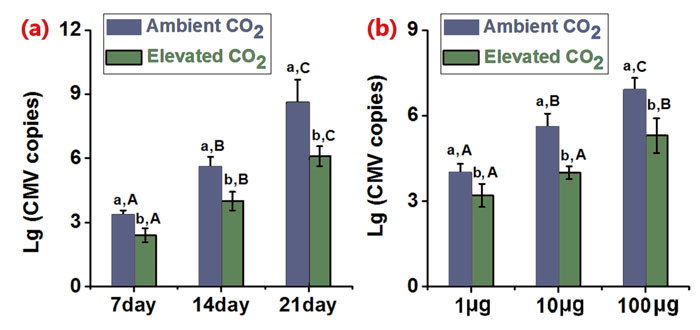| Tweet | Follow @co2science |
Paper Reviewed
Guo, H., Ge, P., Tong, J., Zhang, Y., Peng, X., Zhao, Z., Ge, F. and Sun, Y. 2021. Elevated carbon dioxide levels decreases Cucumber Mosaic Virus accumulation in correlation with greater accumulation of rgs-CaM, an inhibitor of a viral suppressor of RNAi. Plants 10, 59, doi.org/10.3390/plants10010059.
Introducing their work, Guo et al. (2021) write that elevated CO2 alters plant photosynthesis, carbohydrate assimilation and transpiration, which alter primary and secondary metabolism of plant tissues, ultimately affecting plant-pathogen interactions. And in this regard, multiple studies have shown that pathogen infection tends to be reduced in plants exposed to elevated concentrations of atmospheric CO2 as opposed to plants exposed to present-day CO2 levels. But exactly how this suppression occurs at the cellular or molecular level remains to be elucidated.
Shedding some light on this topic, the eight Chinese scientists who authored this study examined the effects of CO2 enrichment on cucumber mosaic virus (CMV) severity in tobacco plants (Nicotiana tabacum). The work was conducted indoors in controlled-environment chambers under ambient (400 ppm) or elevated (700 ppm) CO2 levels. Following four weeks of growth at the respective CO2 levels a portion of the plants in each CO2 treatment were inoculated with CMV and their responses analyzed. In particular, Guo et al. determined to answer whether or not atmospheric CO2 enrichment (1) enhanced plant defense mechanisms in tobacco or (2) weakened virus-mediated mechanisms to overcome plant resistance.
First off, as shown in the figure below, their results revealed that elevated CO2 did indeed significantly reduce the severity of CMV disease. Second, Guo et al. were able to confirm via "direct evidence that the effects of elevated CO2 on the virulence of CMV was correlated with the inability to inhibit RNA silencing in tissue systemically-infected with CMV." In other words, elevated CO2 weakened the ability of CMV to overcome plant resistance, or as the authors additionally write, it "decreased the efficiency of CMV infection." Consequently, these important findings indicate that plants are likely to "suffer less CMV damage [in the future] if atmospheric CO2 levels were to continue to increase," which suggests "important implications for agricultural virus control under anticipated future elevated CO2 conditions." And those implications are that crop yields will experience an overall reduction in CMV-induced losses (and probably a reduction in crop losses due to other viruses as well) as the air's CO2 content continues to rise. In contrast, efforts to reduce the CO2 content of the atmosphere, which is a policy that far too many are presently pursuing, would have an opposite effect; it would increase disease infection and severity and reduce global crop yields.

Figure 1. Elevated CO2 impacts on CMV disease severity in Nicotiana tabacum (the higher the CMV copies, the more severe the disease). Panel (a): accumulation of RNA 3 of CMV in N. tabacum post mechanical inoculation with the virus for 7 days, 14 days and 21 days under ambient CO2 and elevated CO2. Panel (b): accumulation of RNA 3 of CMV in N. tabacum post mechanical inoculation with 1, 10 and 100 µg virus for 14 days under ambient CO2 and elevated CO2. Data represent means ± SE (Tukey's multiple range test, p < 0.05). Different lowercase letters indicate significant differences between ambient CO2 and elevated CO2 within the same time point or virus concentration. Different uppercase letters indicate significant differences among time points or virus concentrations within the same CO2 treatment (p < 0.05). Error bars indicate standard errors. Lg = log to base 10. Source: Guo et al. (2021).




